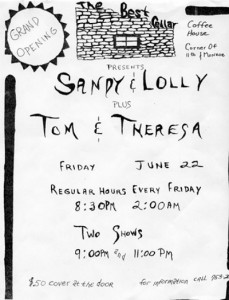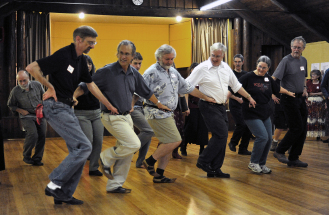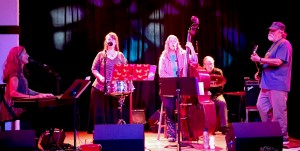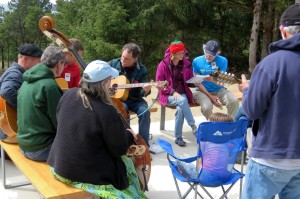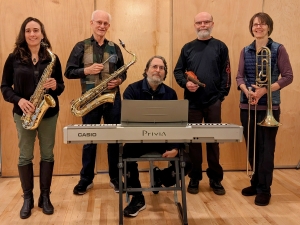To Photos of the 40th year Best Cellar Celebration
The 40th Anniversary Bash of the Best Cellar was celebrated at The First United Methodist Church on June 22, 2013 with music from past performers: Dave & Sharon Thormahlen, Tom & Ellen Demarest, Audrey Perkins, Bill Smyth & Rita Brown, MC Squared, Chris Mundt, John Swanson, Jason Yaich, Dick Thies, Audrey Perkins with Neal Gladstone Band, and Tatiana Hargreaves.
Part 1.**The Best Cellar Coffee House turns 40 by Cory Frye, Corvallis Gaxette Times (2013)
To peruse the evening’s lineup is to travel through time. Many of these names are responsible for the event’s longevity. Some have even been crucial to its survival: Jeff Hino and DeLynn Anderson, Bill Smyth and Rita Brown, MC Squared (Mark Weiss and Cliff and Chere Pereira), Sharon and Dave Thormahlen, and Audrey Perkins, whose pipes sweetened Neal Gladstone’s band.
Eighteen-year-old Tatiana Hargreaves is dropping in to accept an award and perform; her generation represents the promise of the next 40 years. At the other end of the spectrum are Tom and Ellen Demarest. Tom’s the link to the Cellar’s roots. He helped create it and he played that very first night, in the exact same building, on Friday, June 22, 1973 — albeit two floors below, in one of the city’s most famous basements.
Many of that year’s witnesses recall it as an interesting time. The ’60s had ended, and the new decade hadn’t quite yet found its footing. The Vietnam War was winding down; the Watergate scandal was heating up. Change and transition were in the air. People, as always, found solace, solutions and identity in music.
In Corvallis, such sounds were flourishing. Kent Buys’ and Larry Edgar’s Troubadour Music Shop occupied the scene’s epicenter from its original location, carved behind an alley door between Second and Third Streets, about 15 steps from Monroe Avenue. Musicians and devotees would gather there to jam and socialize. After hours they’d move to the nearby Big O Restaurant — current home of ATA Karate for Kids and Vector Marketing — where they’d fortify banter with coffee all night.
Despite the town’s sonic plenitude, at least two crowds were left wanting: minors under legal drinking age and adults weary of smoky, boozy, rowdy rooms. Something had to be done, so in the spring of 1973, Buys approached the First United Methodist Church to propose a weekly nonalcoholic all-ages venue devoted to folk music.
KENT BUYS: I spent three months speaking with their board, explaining why this would be a good mission for the church. They were very open to every kinds of missions meeting. I was a Methodist minister for a while — I got my master’s degree in world religions and the arts at Claremont (School of Theology) — so I’d done a couple of different programs there. They didn’t know in those days about pillows on the floor, music and people with long hair and bright eyes full of energy, so they said, “We’ll do this in a provisional kind of way and see how it works out.”
The series’ founding brain trust consisted of Tom Demarest and his then-wife, Theresa, recruited to manage the project and audition talent; Larry Edgar, who not only gave the Best Cellar its name but has become its very soul; Mark Aron, who worked with Buys at the Children’s Farm Home and would serve as emcee; Jim and Margaret “Muggs” Arnold, handlers of publicity and funds; and musician/painter Tom Wheeler and his then-wife Linda, an Oregon State University junior and food science major who answered to “Ralph.”
LINDA BENSON (formerly Wheeler): Well, my name is Linda, and between 1945 and 1955, I think, one out of every 10 girls born in the United States had that name. When I went to college, I decided I didn’t want to be Linda anymore, so I became Ralph.
After assembling the team, everyone went to work, prepping the church’s basement — and themselves.
TOM DEMAREST: We needed a PA system, which I had. We needed to create a stage, which Tom cobbled together from parts of his painting business shop, and tables, which I agreed to work out. We went to Timber Supply in Philomath and bought four huge logging cable reels. We took them apart, laid the 5-foot ends out in my carport, rented a floor sander, and when we had them looking respectable, we slathered them with Varathane till most of the holes and cracks were filled. We then made bases for these tabletops from 2-foot squares of plywood and the staves from the reels, and we were ready to open. The church supplied the chairs, but we had to carry them all down from the second floor to the basement — and back up every night.
LINDA BENSON: Tom (Wheeler) was painting the brand-new shop for the Beanery, which had just arrived (in its first home, on 21st Street and Monroe Avenue), and he talked them into helping us out with coffee. They loaned us a coffeemaker and we showcased their coffee as advertising.
LARRY EDGAR: After we got done each night, we’d have to take that brewer back — I had a key — to make sure they could brew cups of coffee the next day. (Interestingly, after leaving the Troubadour, Edgar would become a roaster for the company.) (The basement) was a nice, cozy place. There were couches around the walls and a rug on the floor. We tried to make it as close as possible to sitting around at home with a bunch of friends and listening to other friends.
LINDA BENSON: The room had a little kitchen right off of it, and then outside was a pass-through door. There was a bar where we set up our coffee. We got tea from the First Alternative Co-op, and sodas. I was in the kitchen baking chocolate chip cookies.
LARRY EDGAR: The cookies were Linda’s family recipe. Ralph’s Cookies.
The Best Cellar Coffee House debuted at 8:30 p.m. Friday, June 22. The previous afternoon’s Corvallis Gazette-Times described the gathering as targeted toward “senior high school students and young adults,” although everyone was welcome. Two acts would perform two sets — one was usually Tom and Theresa Demarest — beginning at 9 and 11 p.m. Admission was 50 cents (Ralph’s Cookies went quickly at a quarter apiece and were a staple, with modifications, for years), and patrons could hang until 2 a.m., maybe even help clean up, dissemble the stage, tuck its pieces into a corner, roll away the tables and trudge those chairs back upstairs.
The Demarests were joined that first night by two young local dulcimer prodigies, Sandy and Lolly Smith.
SANDY SMITH: Our family had lived in King’s Valley for a brief time in the ’60s then went back down to California. Eventually, as we all finished school, we migrated back to the family property. Lolly, who was 13 months younger, came in ’71, and I came up in ’72. We got involved in the music scene by hanging out with Kent and Larry at the Troubadour and at Grass Roots — this was before I met Jack (Wolcott, Grass Roots’ owner, whom she later married). Those were the places to be.
We’d come from Redondo Beach, with its house parties and festivals. Corvallis was very embracing, very much like what we’d known. Everyone loved us even though we made all kinds of silly mistakes and giggled. We played some Appalachian ditties, some Cat Stevens, some Richard and Mimi Fariña. We were so raw and unrehearsed. As I recall, we had to be talked into doing the Best Cellar. We were really shy.
TOM DEMAREST: As emcee, Mark would sing and play the guitar. I think it was “Stewball” that he’d sing. It was always the source of ridicule. We’d get on Mark about playing “Stewball.”
MARK ARON: “Stewball”? I should ask Tom what he remembers about that. It wasn’t one of my favorite songs. I was kind-of famous for “The Cat Came Back.” I had a great rendition of that. But the music that I really loved was Pete Seeger and The Weavers. We’d often sing “Goodnight, Irene,” Lead Belly — you know, folk songs. Folk music was so clearly a unifying force in our lives. It was such an important part of the ’60s, bringing people together, keeping their spirits up in the face of the Vietnam War as a form of protest and solidarity. It was fun to be part of something that provided an opportunity for the folk community in Corvallis to come together.
Seventy-five people attended that first night, setting a promising precedent. For a time the Best Cellar became such a hot ticket that it added a Saturday show. Young and old came in droves. Later that fall, OSU Barometer reporter Barb Reynolds stopped in to investigate. She entered a skeptic and emerged a believer.
BARB REYNOLDS (“Mellow music draws crowd to coffeehouse,” Tuesday, Oct. 2, 1973): “When I finally left two and one half hours later, humming some Appalachian ballad of lost love and walking to the rhythm, I thought about all the notions they had shattered. There were, so to speak, all kinds present. At one table was a group of men and women in their 50s or 60s. Next to them, a few lettermen and their girls … some longhairs, some short hairs, some singles, some high-schoolers. And every one of them clapping, stomping, singing along to a rocking, mellow ‘Sweet Chariot’ or Cat Stevens’ ‘Sitting.’”
TOM DEMAREST: There was turnover, which is part of the reason we had two sets. People would come in and then the older folks would come in after they’d gone to dinner. It got a reputation pretty quickly as a place to hear good music. Folk was obviously a very trendy thing then, and once people on campus came out, after that Barometer article came out, that created an awareness. Fifty cents a head, of course, is going to be appealing.
Posters from that season advertise such notables as Marshall Adams; Don Williams; Gary Nolde; Judy Grossfield (now Fjell); the influential Magpie, a name still invoked with awe; the unforgettably christened Anvil People from the Metal Galaxy; and Sid Beam.
One guest went unmentioned, because no one knew if he’d come. But he proved quite the coup when he did take the stage: singer-songwriter Daniel Moore, brother to Children’s Farm Home assistant director Paul Moore and the scribe behind the No. 3 song in the country that week: “Shambala,” as recorded by Three Dog Night.
TOM DEMAREST: Kent Buys would have people come out to the Farm Home and play for the kids. Theresa and I were there for a talent night or something and Daniel was visiting his brother. So we asked him if he’d consider playing the Best Cellar and he agreed. He did a really nice set; I had it on reel-to-reel tape.
LINDA BENSON: Tom and Theresa would do his “Oregon (Give Me Wings).” That was one of my favorites.
TOM DEMAREST: The last I heard from Daniel was about a year ago, when he heard that Oregon was looking for a state song. So he contacted me and said, “Do you know some people at OSU who might know some of the people involved with this?” He sent me a chorale performance he’d had done in L.A., plus some sheet music. I’ve recorded it on a couple of occasions, and we still do it. It’s a great song.
The Demarests exited to pursue other local and out-of-town dates, taking their PA with them (the couple separated in 1977; Tom met Ellen the following year, and Theresa now lives in Portland). Larry Edgar began manning the sound, a role he relishes to this day.
In fact, he’s the only remaining member of the original crew. No one’s sure what became of the Arnolds; Margaret’s reportedly still in the valley, while Demarest thinks Jim’s in the Bay Area. Tom and Linda Wheeler moved to Alaska in 1974 and wouldn’t return until 1987. (Tom now resides in the Tillamook region.) Mark Aron went east to Boston in 1980 for graduate school. Like the cat he came back, in 1986.
During that time the Best Cellar grew. But as the ’70s drew to a close, it appeared as if the series might vanish with them.
MARK WEISS: By 1976, when I came to town, it was going full hog. But Larry Edgar was the only person coordinating it. He had some folks helping out, but he basically did all the work. He moved the equipment, did the sound, coordinated performers — all of it. Those of us who were interested formed three little work groups with about six or eight people in each. But those groups began to burn out a little bit and people moved away. I was worried it was going to end altogether, so I wrote to the Corvallis Folklore Society, which had started not long after the Best Cellar, and asked them to take it. I told them it was a worthwhile community event.
John Swanson answered the call, relaunching the Best Cellar under the CFS umbrella on Saturday, Feb. 23, 1980. That evening’s entertainment featured sea shanties spun by Craig Hollingsworth and Clyde Curley, followed by the Maple Trio of Nancy Spencer, Judy Fjell and the aforementioned Mr. Weiss. During Swanson’s year at the helm, it became a monthly event and moved from Saturday to Friday to avoid conflicting with the organization’s popular weekly dance.
Dick Thies succeeded Swanson in 1981, briefly adding a song circle to the format. Although that element didn’t catch on (he was more successful with his own song circles), the event itself remained popular, attracting such talent as Momma Mega, the Big Chicken String Band, the Babushka Sisters, Ed Telcs, Dan Mahoney and Sunny McHale Skydancer.
DICK THIES: If you put the word out, people wanted to do it. It was considered a very friendly venue and a nice place to play. Larry was a professional sound man, so that was nice too. A lot of people knew he’d treat them well. The Best Cellar was drawing very good crowds.
In fact, they were getting bigger. Thies bowed out in 1983 to become the Folklore Society’s newsletter editor, a position he’s happily held since. Into his place stepped Anne Warren Smith, whose nine-year term saw the Cellar reach its peak, necessitating a change of address.
ANNE WARREN SMITH: At that time we still had the Silver Falls Music Weekend, where all the folk musicians would get together and play music all day long. There’d be workshops here and there and spontaneous things. At the Saturday night concerts, I’d take notes and decide who I wanted to approach for the following year’s Best Cellar. That’s where I got so many wonderful performers.
Audiences proved just as plentiful — too large, actually, to be contained in a basment. The Folklore Society was forced to find another venue, hopefully one that could accommodate sizable groups without sacrificing the series’ appeal. They settled on the Odd Fellows Hall, where the Best Cellar flourished from 1989 to 1996. Local favorite Neal Gladstone wrapped multiple seasons as the “surprise guest,” although everyone caught on quickly and were ready to join in on “Save Our Planet.”
NEAL GLADSTONE: “These are the people, celebrate the people / May you always love your fill / We can save the treasure if we stand together / And celebrate the people.”
ANNE WARREN SMITH: Some of us thought we’d ruined it by moving it up there. It became different. It turned into a concert setting instead of a coffeehouse setting. There was consternation.
In response, autoharp innovator and musician Jon ten Broek established a smaller companion series, the Second Cup, which opened in June 1990 at the Methodist church, but this time in a different part of the basement (The original space was renovated into a choir practice room), where it prospered for nearly six years. Smith stepped down during this period after a long and prestigious run.
ANNE WARREN SMITH: I have this philosophy: If you’re going to do a volunteer job, five years is it. But when we moved to Odd Fellows Hall, I thought, “I’ve got to see this through.” I gave it four more years just because I felt so responsible. But it was time.
The Best Cellar would occupy the Odd Fellows for more than half a decade, requiring Larry Edgar to repeatedly navigate stairs with multiple gear deliveries. It was tough, but he persevered for the cause he loved so much.
LARRY EDGAR: It took between six and eight trips, depending on how many mike stands I needed and things like that. I was grateful for the landing in the middle. (laughs)
The series would relocate a number of times after vacating the larger room — the Old World Center and the First Congregational United Church of Christ, among them — under the stewardships of Brian Pearson (1995-97), Bill Smyth (1997-2003) and Jason and Sally Yaich (2003-06).
But eventually the Cellar made its way home, and Mark Weiss, now in his second term (he also served from 1992-95), couldn’t be happier. What began as a capital idea — homegrown talent uniting music lovers of all ages — has become a cherished institution, outliving hordes of trends, festivals, cycles and scenes. It’s lasted this long not because it’s popular, but because it’s necessary.
MARK WEISS: It’s in a very solid niche in Corvallis: The music feels like a concert atmosphere, but the space is small, so it also feels more intimate. There’s a certain love of the music and a certain love of community that continues to permeate the Cellar. Whenever it appears to be taking its last gasp, someone or a group of people step forward. It’s meant too much to too many to just let it go. Also, there’s Larry. He’s one of the best sound men around, and we’re lucky to have him. Our 35th anniversary was a tribute night for him and musicians came from everywhere.
LARRY EDGAR: I’m really pleased our little baby has lasted this long. I still enjoy doing sound for it. I’ve heard a lot of good music and met a lot of very nice people.
DICK THIES: It was always a good venue. The enjoyment of having an appreciative audience is what keeps it going.
TOM DEMAREST: Folk music is a cross-generational form. A lot of the music from that time period is a great common denominator between my generation and a couple of generations behind me. The reason the Best Cellar’s still around is because a lot of people like the music.
LINDA BENSON: It’s one of those universal things. People like to get together and listen to music. It was a good time, a really good time, for all of us involved. I still think it’s an absolutely fantastic idea.
MARK ARON: Music connects us. It lifts us and gives us such soaring pleasure. It captures grief, tragedy, success and accomplishment. It helps us get through this old world. It’s not the physical location, but the spirit of the place.
Special thanks to Mark Aron, Linda Benson, Kent Buys, the Corvallis Folklore Society, Tom Demarest, Larry Edgar, Julia Sandidge, Anne Warren Smith, Sandy Smith, Dick Thies, Mark Weiss and the staff at the Valley Library. •
At the time this was written, Cory Frye was a calendar editor and Entertainer reporter for the Corvallis Gazette-Times and could be reached at 541-758-9514 or by email at cory.frye@lee.net.

